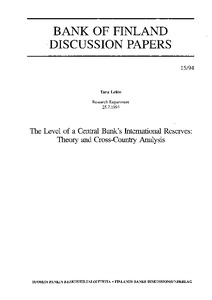The level of a central bank's international reserves : theory and cross-country analysis
Lehto, Taru (25.07.1994)
Numero
15/1994Julkaisija
Suomen Pankki
1994
Julkaisun pysyvä osoite on
https://urn.fi/URN:NBN:fi:bof-20140807425Tiivistelmä
The study introduces the theory of the level of foreign exchange reserves and examines, in light of prior research, the different factors that affect the demand for reserves.The empirical part of the study uses results based on new and more extensive data to discuss the validity of the dependency relationships that have been found in previous studies and compares developments in Finland's foreign exchange reserves with those of other countries. The data used in the empirical analysis covers the period 1974-1991 for 56 different countries, of which 22 are industrialized countries and 34 are less-developed countries.The basic analysis uses unweighted least squares regressions on cross-section data. Also, results from two weighted regressions are examined.The time series and cross-section data for industrialized countries are also pooled for testing purposes and the results are compared with those from the normal least squares regressions. The degree of openness is an important determinant of the level of foreign exchange reserves for both industrialized and less- developed countries: the larger a country's foreign trade relative to total output the more reserves it demands.The results of the study also indicate that money growth increases the need for reserves and that the interest rate level is negatively correlated with the relative reserve level, at least in the less-developed countries.In the industrialized countries, the demand for reserves increases as yearly balance of payments' fluctuations increase. Moreover, the amount of reserves adjusts slowly to its long-run target level.
